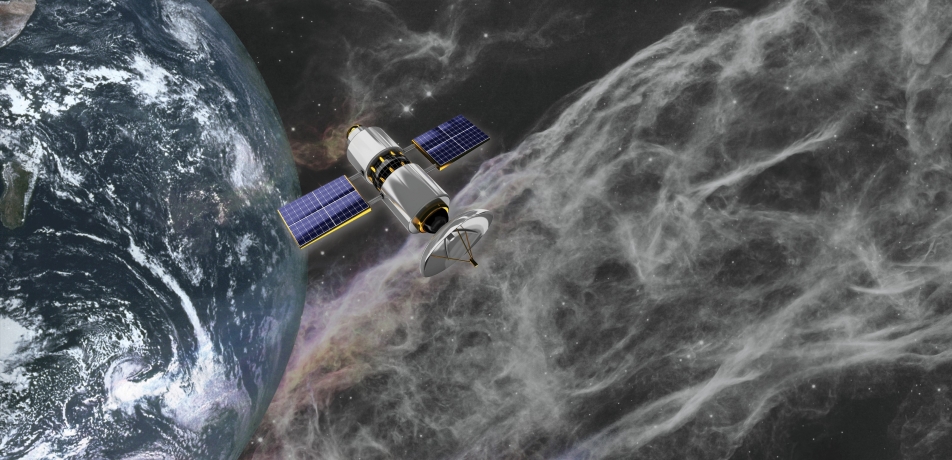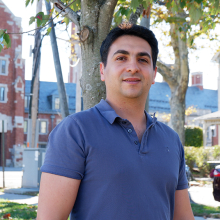Frontiers of the Universe
Flagship project launches Weizmann on an odyssey toward the future of physics
Features

The Universe is everything, from the tiniest sub-atomic particles to the largest galaxies, to the very existence of space, time, and life itself. But how did it all begin, and how did primordial events lead to the shape—and the content—of the cosmos? These are the fundamental scientific questions behind a new flagship initiative at the Weizmann Institute of Science called Frontiers of the Universe.
Designed to capitalize on Institute expertise in both particle physics and astrophysics research—the study of phenomena that occur over infinitesimal distances, and at the grandest scale—the Frontiers project will create a powerful, integrative framework for solving mysteries related to cosmology, the branch of science that explores our Universe’s ancient origins. At the same time, it will generate new methods for characterizing physics as it plays out at both ends of the scale—from the quantum distances that separate atoms from their nearest neighbors, to the unfathomably distant reaches of outer space.
Building on the Weizmann Institute’s recognized global leadership in the study of physical systems—both the very large and the very small—the Frontiers initiative, which will be housed in a new building, is expected to generate an unprecedented, wide-lens view of where the Universe has been, where it is going, and how.
The initiative will include multiple research sub-centers that will support the range of investigations required to develop new methods and technologies to advance astrophysics, particle physics, and the physics theory that binds it all together.
The history (and science) of everything
Throughout history, different cultures have put forth foundation myths about the Universe’s origins. In the modern scientific community, however, the debate has been settled by the Big Bang Theory, which neatly encapsulates the life story of the Universe, and also explains the genesis of the fundamental particles that are the source of everything we know—as well as an uncountable number of things that we don’t know yet.
According to the Big Bang Theory, the Universe began some 14 billion years ago as an unimaginably hot and dense place that suddenly exploded, then later expanded and cooled. Under these cooler conditions, sub-atomic particles fused, creating the first simple chemical elements, and—eventually—forming clouds of atoms from which galaxies would arise. Inside these galaxies, gravity caused atomic clouds to coalesce, forming stars. The new stars’ tremendous internal heat drove nuclear reactions that forged almost all the Universe’s remaining elements. Finally, these stars would explode, ejecting elements that would become the building blocks of planets, moons, and every form of organic life—including human beings.
ULTRASAT
The night sky is a window to the distant past, with transient events such as the collisions and explosions of stars—invisible to the naked eye here on Earth—bearing fleeting witness to celestial episodes that occurred billions of years ago. A central component of the Frontiers of the Universe initiative will be ULTRASAT, a satellite designed by Weizmann physicists Prof. Eli Waxman and Prof. Avishay Gal-Yam that will help the world’s astrophysics community capture and “read” the messages hidden in transient, cosmic events before they fade away. By advancing our understanding of the Universe’s origins and development, the ULTRASAT project is expected to place Israel at the forefront of world astrophysics research and discovery.
Fitted with a telescope designed to observe the Universe as it has not been seen before, ULTRASAT will be a small and relatively affordable satellite that focuses on ultraviolet (UV) emissions, and captures images of an unprecedentedly wide swath of the night sky. It will gather and transmit the data it collects in real time, alerting the world astrophysics community to point their land-based telescopes toward transient events that might otherwise be overlooked.
ULTRASAT will be capable of detecting and measuring the UV emissions generated by the explosions of stars and other phenomena minutes after they occur, rather than the days or weeks required by current telescopic systems. Its continuous observations are expected to generate a “discovery rate”—the rate at which celestial events are identified—that is 300 times greater than today’s technologies. The data it streams to Earth will be analyzed in a new project center on campus.
Analysis of data from the ULTRASAT mission is expected to help answer some of astrophysics’ most important questions: How do stars merge and emit gravitational waves? How do supermassive black holes affect the “fabric” of space? How do stars explode? What is the birth story behind the Universe’s heavy elements? How fast is the Universe expanding? Which stars are most likely to have planets able to sustain life?
An official kickoff ceremony for the mission, held on campus, celebrated the signing of a joint agreement between the Weizmann Institute, the Israel Space Agency, and the Helmholtz Association of German Research Centers. Additional collaborative support will come from the European Space Agency, as well as from NASA, which has agreed to help facilitate the satellite launch, scheduled for 2023.
Adding to the astrophysics toolbox
Weizmann Institute astrophysicists are contributing other new methods and technologies that will improve our understanding of outer space. For example, recent faculty recruit Dr. Sagi Ben-Ami is developing a novel way to detect “bio-signatures”—substances that provide scientific evidence of past or present life—on planets outside of our solar system. Using this approach, he plans to map and monitor approximately 200,000 stars, and to narrow down the list of stars with orbiting planets that have an atmosphere capable of supporting life.
Prof. Eran Ofek—another key member of the ULTRASAT team—is a technology innovator who has built a new type of telescope, capable of capturing the “dimming” of light that occurs when comets cross between the Earth and a distant star. These advances, and others like it, will help Weizmann Institute scientists fill in the “big picture” of the Universe.
ATLAS leaders
Colder than outer space, yet able to smash particles together at energies a million times higher than the sun does, the Large Hadron Collider at CERN is the world’s most powerful particle accelerator. The largest machine ever built, the LHC rests in a 27 km (19 mile) long circular tunnel, dug 100 m (328 feet) below ground on the border between France and Switzerland. The mission of the LHC is as simple as it is ambitious: to find “missing pieces” within and beyond the Standard Model of physics—the best theory we have to describe the fundamental building blocks of the Universe.
Weizmann Institute scientists are prominent leaders in ATLAS, an international collaboration that is one of the four cornerstones of the LHC. The 7,000-ton ATLAS detector—the largest ever constructed for a particle accelerator—is designed to detect and record the trajectory, momentum and energy of particles as they collide. Over 40 million collisions take place in the ATLAS detector every second, generating vast amounts of data analyzed at 130 computing centers around the globe.
Members of the Weizmann Institute’s Department of Particle Physics and Astrophysics—Dr. Shikma Bressler, Prof. Ehud Duchovni, Prof. Eilam Gross, as well as recently recruited faculty member Dr. Noam Tal Hod—have been involved in the design, construction, management, and operation of the ATLAS detector’s largest subsystem, which was actually built on the Weizmann Institute campus. Weizmann scientists also made a significant contribution to CERN’s most dramatic discovery to date: a long-predicted piece of the particle science puzzle called the Higgs boson. This elementary particle, the last hold-out particle remaining hidden during the quest to check the accuracy of the Standard Model, verified the existence of the Higgs field—energy thought to exist everywhere in the Universe, and which is necessary to explain why certain particles, and not others, have the property of mass.
New detectors for neutrino physics
Dr. Shikma Bressler, a member of the ATLAS team, develops technologies for future experiments in particle physics. She recently created a new device that could potentially improve the way the detectors in particle accelerators identify neutrinos—a nearly massless type of subatomic particle that rarely interacts with normal matter. Dr. Bressler’s device may offer a solution to unanswered questions in the study of the quantum world.
This and other technological advances, which emerged from Weizmann Institute labs, may help particle physicists reveal the laws that govern how particles combine to create everything we know. As part of the Frontiers of the Universe initiative, scientific activity like this—pursued in tandem with astrophysics research—will paint a new picture of how the world works, on every scale.
Theory leads the way
Space missions and particle accelerators are expensive—and that’s an understatement. In theoretical physics, however, dramatic progress can be achieved by just gathering the best minds together for coffee and a little conversation. This is the “business model” behind the Schwartz/Reisman Institute for Theoretical Physics (SRitp), which will complement the Frontiers of the Universe initiative.
Established by a major gift from Gerald Schwartz and Heather Reisman of Toronto, the SRitp has a three-fold mission: to highlight the exceptional theoretical physics work at the Weizmann Institute, attract world-leading theoreticians to the campus, and create the personal connections that can lead to fruitful international collaboration.
Following the successful model established by a handful of other theoretical physics institutes—most notably at the University of California, Santa Barbara, and including Germany’s Johannes Gutenberg University Mainz—SRitp sponsors workshops focused on emerging questions, including recent gatherings devoted to quantum physics, fluid mechanics, and so-called fast radio bursts (FRBs)—transient pulses emerging from deep space. Whatever the topic, such discussions help bridge gaps between scientific worldviews, bringing us closer to a comprehensive understanding of the world’s physical laws.
Dr. Sagi Ben–Ami's research is supported by The Norman E Alexander Family M Foundation; André Deloro Institute for Advanced Research in Space and Optics; Peter and Patricia Gruber Awards; Willner Family Leadership Institute for the Weizmann Institute of Science
Dr. Shikma Bressler's research is supported by Sir Charles Clore Prize; Martin Kushner Schnur; Yeda-Sela Center for Basic Research; Schwartz/Reisman Collaborative Science Program; Dr. Barry Sherman Institute for Medicinal Chemistry; Dianne and Irving Kipnes Foundation, Carolyn Hewitt and Anne Christopoulos, in Memory of Sam Switzer; Sam (Ousher) Switzer & Children ; Yeda-Sela Center for Basic Research; European Research Council
Prof. Ehud Duchovni's research is supported by Nella and Leon Benoziyo Center for High Energy Physics; Prof. Duchovni is the incumbent of the Professor Wolfgang Gentner Professorial Chair of Nuclear Physics
Prof. Avishay Gal-Yam's research is supported by Benoziyo Endowment Fund for the Advancement of Science; André Deloro Institute for Advanced Research in Space and Optics; Veronika A. Rabl Physics Discretionary Fund; Schwartz/Reisman Collaborative Science Program; European Research Council
Eilam Gross's research is supported by Nella and Leon Benoziyo Center for High Energy Physics
Prof. Yohai Kaspi's research is supported by de Botton Center for Marine Science; André Deloro Institute for Advanced Research in Space and Optics; Helen Kimmel Center for Planetary Science; Schwartz/Reisman Institute for Theoretical Physics
Prof. Eran Ofek's research is supported by The Norman E Alexander Family M Foundation; André Deloro Institute for Advanced Research in Space and Optics; Schwartz/Reisman Collaborative Science Program; Willner Family Leadership Institute for the Weizmann Institute of Science
Prof. Eli Waxman's research is supported b Ety and David Alcalay Ș Norman E Alexander Family M Foundation; Nella and Leon Benoziyo Center for Astrophysics; Schwartz/Reisman Collaborative Science Program; Schwartz/Reisman Institute for Theoretical Physics; Willner Family Leadership Institute for the Weizmann Institute of Science; Prof. Waxman is the incumbent of the Max Planck Professorial Chair of Quantum Physics
ULTRASAT supporters Norman E Alexander Family M Foundation; Ety and David Alcalay

Architectural designs by MYS Architects








